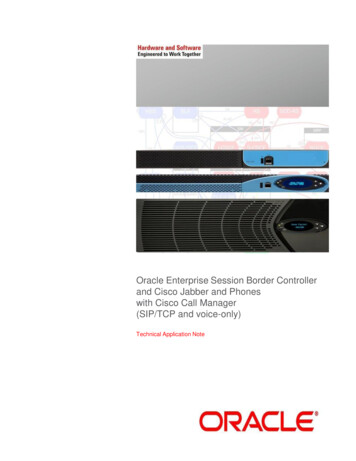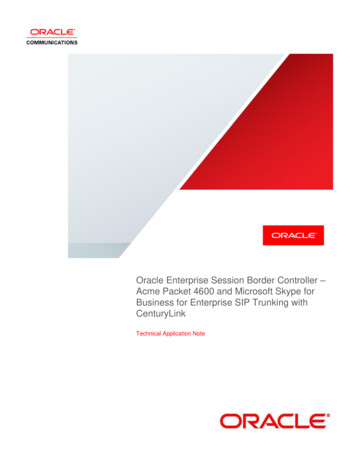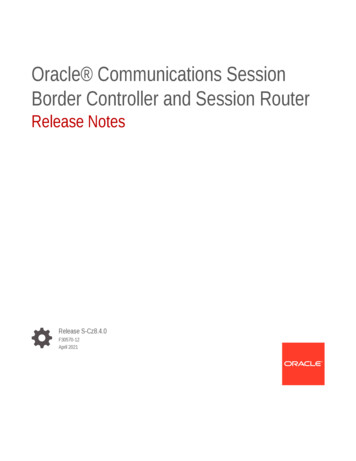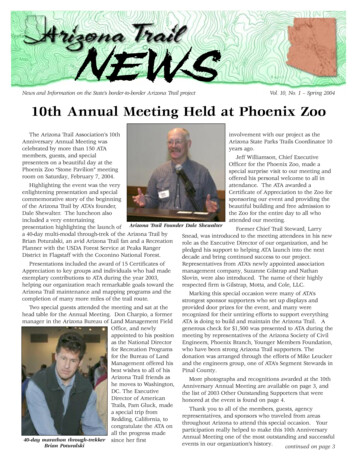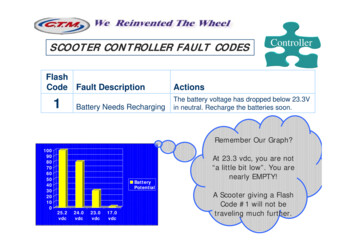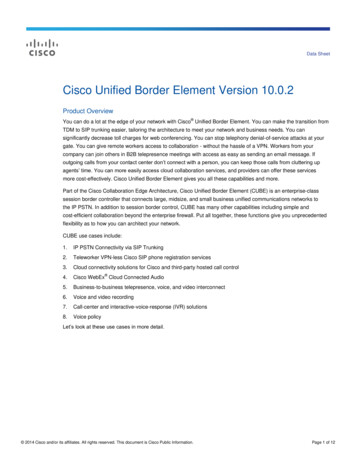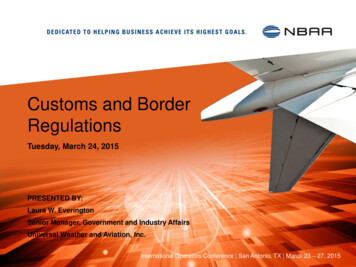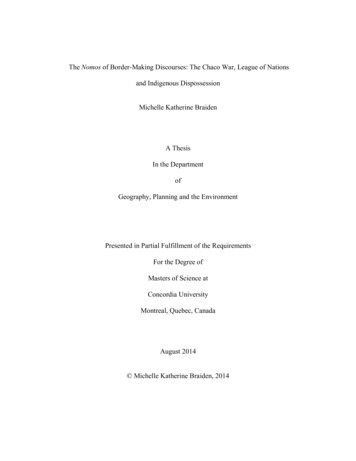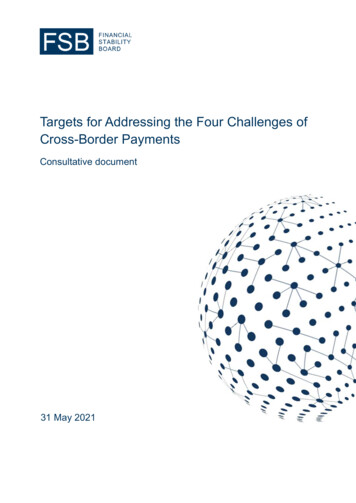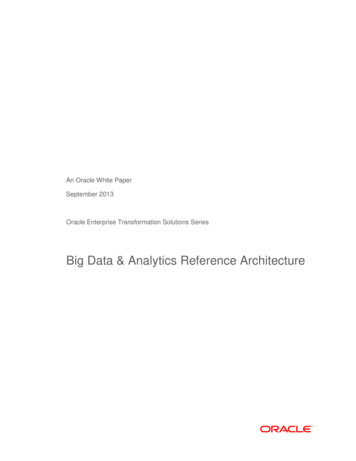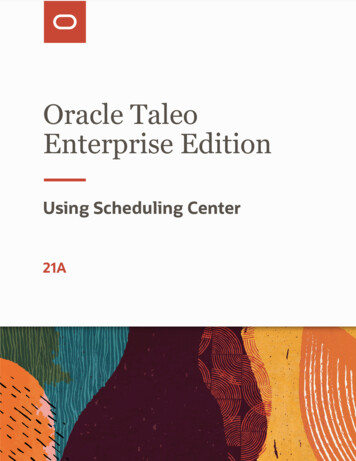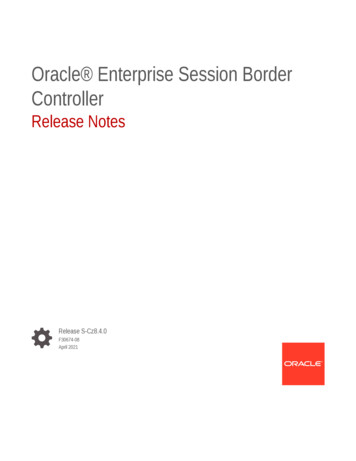
Transcription
Oracle Enterprise Session BorderControllerRelease NotesRelease S-Cz8.4.0F30674-08April 2021
Oracle Enterprise Session Border Controller Release Notes, Release S-Cz8.4.0F30674-08Copyright 2014, 2021, Oracle and/or its affiliates.Primary Authors: (primary author), (primary author)Contributing Authors: (contributing author), (contributing author)Contributors: (contributor), (contributor)This software and related documentation are provided under a license agreement containing restrictions onuse and disclosure and are protected by intellectual property laws. Except as expressly permitted in yourlicense agreement or allowed by law, you may not use, copy, reproduce, translate, broadcast, modify, license,transmit, distribute, exhibit, perform, publish, or display any part, in any form, or by any means. Reverseengineering, disassembly, or decompilation of this software, unless required by law for interoperability, isprohibited.The information contained herein is subject to change without notice and is not warranted to be error-free. Ifyou find any errors, please report them to us in writing.If this is software or related documentation that is delivered to the U.S. Government or anyone licensing it onbehalf of the U.S. Government, then the following notice is applicable:U.S. GOVERNMENT END USERS: Oracle programs (including any operating system, integrated software,any programs embedded, installed or activated on delivered hardware, and modifications of such programs)and Oracle computer documentation or other Oracle data delivered to or accessed by U.S. Governmentend users are "commercial computer software" or "commercial computer software documentation" pursuantto the applicable Federal Acquisition Regulation and agency-specific supplemental regulations. As such,the use, reproduction, duplication, release, display, disclosure, modification, preparation of derivative works,and/or adaptation of i) Oracle programs (including any operating system, integrated software, any programsembedded, installed or activated on delivered hardware, and modifications of such programs), ii) Oraclecomputer documentation and/or iii) other Oracle data, is subject to the rights and limitations specified in thelicense contained in the applicable contract. The terms governing the U.S. Government’s use of Oracle cloudservices are defined by the applicable contract for such services. No other rights are granted to the U.S.Government.This software or hardware is developed for general use in a variety of information management applications.It is not developed or intended for use in any inherently dangerous applications, including applications thatmay create a risk of personal injury. If you use this software or hardware in dangerous applications, then youshall be responsible to take all appropriate fail-safe, backup, redundancy, and other measures to ensure itssafe use. Oracle Corporation and its affiliates disclaim any liability for any damages caused by use of thissoftware or hardware in dangerous applications.Oracle and Java are registered trademarks of Oracle and/or its affiliates. Other names may be trademarks oftheir respective owners.Intel and Intel Inside are trademarks or registered trademarks of Intel Corporation. All SPARC trademarks areused under license and are trademarks or registered trademarks of SPARC International, Inc. AMD, Epyc,and the AMD logo are trademarks or registered trademarks of Advanced Micro Devices. UNIX is a registeredtrademark of The Open Group.This software or hardware and documentation may provide access to or information about content, products,and services from third parties. Oracle Corporation and its affiliates are not responsible for and expresslydisclaim all warranties of any kind with respect to third-party content, products, and services unless otherwiseset forth in an applicable agreement between you and Oracle. Oracle Corporation and its affiliates will notbe responsible for any loss, costs, or damages incurred due to your access to or use of third-party content,products, or services, except as set forth in an applicable agreement between you and Oracle.
ContentsAbout This GuideMy Oracle SupportviiRevision History1Introduction to S-Cz8.4.0Supported Platforms1-1Supported Physical Platforms1-1Supported Private Virtual Infrastructures and Public Clouds1-1Requirements for Machines on Private Virtual Infrastructures1-4PCIe Transcoding Card Requirements1-6Oracle Communications Session Router Recommendations for Netra andOracle Servers1-6Browser Support1-6Image Files and Boot Files1-7Boot Loader Requirements1-8Setup Product1-8Upgrade Information1-9Upgrade Checklist1-10Upgrade and Downgrade Caveats1-10Feature EntitlementsEncryption for Virtual SBC1-161-16System Capacities1-17Transcoding Support1-17Coproduct Support1-19TLS Cipher Updates1-20Behavioral Changes1-21Documentation Changes1-23Documentation Changes for S-Cz8.4.0 p51-23Documentation Changes for S-Cz8.4.0 p21-23Documentation Changes for S-Cz8.4.01-23iii
Patches Included in This Release1-24Supported SPL Engines1-24FIPS and JITC Compliance1-24OESBC Features Not Available for the OCSBC1-252New Features3Interface Changes4ACLI Configuration Element Changes3-1ACLI Command Changes3-5Accounting Changes3-6SNMP/MIB Changes3-10Alarms3-11HDR3-11Web GUI Changes3-11Web GUI Changes for S-Cz8.4.0p53-11Web GUI Changes for S-Cz8.4.0p23-12Web GUI Changes for S-Cz8.4.03-13Caveats and Known IssuesKnown Issues4-1Web GUI Known Issues4-18Caveats and Limitations4-24Web GUI Caveats4-27Limitations Removed4-28iv
About This GuideThe Release Notes describe new features, enhancements, supported platforms,upgrade paths, limitations, known issues, resolved issues, and caveats for theOracle Enterprise Session Border Controller (E-SBC).Documentation SetThe following table describes the documentation set for this release.ACLI ConfigurationGuideContains conceptual and procedural information forconfiguring, administering, and troubleshooting the E-SBC.ACLI Reference Guide Contains explanations of how to use the ACLI, as analphabetical listings and descriptions of all ACLI commandsand configuration parameters.Administrative Security Contains conceptual and procedural information forGuidesupporting the Admin Security, Admin Security with ACP, andJITC feature sets on the E-SBC.Call Traffic MonitoringGuideContains conceptual and procedural information forconfiguration using the tools and protocols required tomanage call traffic on the E-SBC.FIPS ComplianceGuideContains conceptual and procedural information about FIPScompliance on the E-SBC.HMR GuideContains conceptual and procedural information for headermanipulation. Includes rules, use cases, configuration,import, export, and examples.Installation andPlatform PreparationGuideContains conceptual and procedural information for systemprovisioning, software installations, and upgrades.Release NotesContains information about this release, including platformsupport, new features, caveats, known issues, andlimitations.SBC Family SecurityGuideContains information about security considerations and bestpractices from a network and application security perspectivefor the Oracle Communications Session Delivery Productfamily of products.Time DivisionMultiplexing GuideContains the concepts and procedures necessary forinstalling, configuring, and administering Time DivisionMultiplexing (TDM) on the Acme Packet 1100 and the AcmePacket 3900.v
About This GuideWeb GUI User GuideContains conceptual and procedural information for using thetools and features of the E-SBC Web GUI.Related DocumentationThe following list describes related documentation for the Oracle Enterprise SessionBorder Controller. You can find the listed documents on s/ in the "Session Border Controller Documentation" and"Acme Packet" sections.Document NameDocument DescriptionAcme Packet 3900 HardwareInstallation GuideContains information about the components andinstallation of the Acme Packet 3900.Acme Packet 4600 HardwareInstallation GuideContains information about the components andinstallation of the Acme Packet 4600.Acme Packet 6100 HardwareInstallation GuideContains information about the components andinstallation of the Acme Packet 6100.Acme Packet 6300 HardwareInstallation GuideContains information about the components andinstallation of the Acme Packet 6300.Acme Packet 6350 HardwareInstallation GuideContains information about the components andinstallation of the Acme Packet 6350.Release NotesContains information about the currentdocumentation set release, including new featuresand management changes.ACLI Configuration GuideContains information about the administration andsoftware configuration of the Service ProviderSession Border Controller (SBC).ACLI Reference GuideContains explanations of how to use the ACLI, asan alphabetical listings and descriptions of all ACLIcommands and configuration parameters.Maintenance and TroubleshootingGuideContains information about SBC logs, performanceannouncements, system management, inventorymanagement, upgrades, working with configurations,and managing backups and archives.MIB Reference GuideContains information about Management InformationBase (MIBs), Oracle Communication's enterpriseMIBs, general trap information, including specificdetails about standard traps and enterprise traps,Simple Network Management Protocol (SNMP) GETquery information (including standard and enterpriseSNMP GET query names, object identifier namesand numbers, and descriptions), examples of scalarand table objects.Accounting GuideContains information about the SBC’s accountingsupport, including details about RADIUS andDiameter accounting.HDR Resource GuideContains information about the SBC’s Historical DataRecording (HDR) feature. This guide includes HDRconfiguration and system-wide statistical information.Administrative Security EssentialsContains information about the SBC’s support for itsAdministrative Security license.SBC Family Security GuideContains information about security considerationsand best practices from a network and applicationsecurity perspective for the SBC family of products.vi
About This GuideDocument NameDocument DescriptionInstallation and Platform PreparationGuideContains information about upgrading system imagesand any pre-boot system provisioning.Call Traffic Monitoring GuideContains information about traffic monitoring andpacket traces as collected on the system. This guidealso includes WebGUI configuration used for the SIPMonitor and Trace application.FIPS Compliance GuideContains conceptual and procedural information forconfiguration using the tools and protocols requiredto manage call traffic on the SBC.HMR Resource GuideContains information about configuring and usingHeader Manipulation Rules to manage service traffic.TSCF SDK GuideContains information about the client-side SDK thatfacilitates the creation of secure tunnels between aclient application and the TSCF of the SBC.REST API GuideContains information about the supported REST APIsand how to use the REST API interface.Oracle Communications SubscriberAware Load Balancer Essentials GuideContains information on how to use the SBC asa cluster member of the Oracle CommunicationsSubscriber Aware Load Balancer.Documentation AccessibilityFor information about Oracle's commitment to accessibility, visit theOracle Accessibility Program website at http://www.oracle.com/pls/topic/lookup?ctx acc&id docacc.My Oracle SupportMy Oracle Support (https://support.oracle.com) is your initial point of contact for allproduct support and training needs. A representative at Customer Access Support(CAS) can assist you with My Oracle Support registration.Call the CAS main number at 1-800-223-1711 (toll-free in the US), or call the OracleSupport hotline for your local country from the list at l. When calling, make the selections in the sequence shown belowon the Support telephone menu:1.Select 2 for New Service Request.2.Select 3 for Hardware, Networking, and Solaris Operating System Support.3.Select one of the following options: For technical issues such as creating a new Service Request (SR), select 1. For non-technical issues such as registration or assistance with My OracleSupport, select 2.You are connected to a live agent who can assist you with My Oracle Supportregistration and opening a support ticket.My Oracle Support is available 24 hours a day, 7 days a week, 365 days a year.vii
About This GuideEmergency ResponseIn the event of a critical service situation, emergency response is offered by theCustomer Access Support (CAS) main number at 1-800-223-1711 (toll-free in theUS), or call the Oracle Support hotline for your local country from the list at l. The emergency response providesimmediate coverage, automatic escalation, and other features to ensure that thecritical situation is resolved as rapidly as possible.A critical situation is defined as a problem with the installed equipment that severelyaffects service, traffic, or maintenance capabilities, and requires immediate correctiveaction. Critical situations affect service and/or system operation resulting in one orseveral of these situations: A total system failure that results in loss of all transaction processing capability Significant reduction in system capacity or traffic handling capability Loss of the system's ability to perform automatic system reconfiguration Inability to restart a processor or the system Corruption of system databases that requires service affecting corrective actions Loss of access for maintenance or recovery operations Loss of the system ability to provide any required critical or major troublenotificationAny other problem severely affecting service, capacity/traffic, billing, and maintenancecapabilities may be defined as critical by prior discussion and agreement with Oracle.Locate Product Documentation on the Oracle Help Center SiteOracle Communications customer documentation is available on the web at the OracleHelp Center (OHC) site, http://docs.oracle.com. You do not have to register to accessthese documents. Viewing these files requires Adobe Acrobat Reader, which can bedownloaded at http://www.adobe.com.1.Access the Oracle Help Center site at http://docs.oracle.com.2.Click Industries.3.Under the Oracle Communications sub-header, click the Oracle Communicationsdocumentation link.The Communications Documentation page appears. Most products covered bythese documentation sets appear under the headings "Network Session Deliveryand Control Infrastructure" or "Platforms."4.Click on your Product and then Release Number.A list of the entire documentation set for the selected product and release appears.5.To download a file to your location, right-click the PDF link, select Save target as(or similar command based on your browser), and save to a local folder.Access to Oracle SupportOracle customers that have purchased support have access to electronic supportthrough My Oracle Support. For information, visit http://www.oracle.com/pls/topic/lookup?ctx acc&id info or visit http://www.oracle.com/pls/topic/lookup?ctx acc&id trsif you are hearing impaired.viii
Revision HistoryThe following table shows the dates and descriptions of revisions to the S-Cz8.4.0Release Notes.DateDescriptionJune 2020 Initial ReleaseJuly 2020 Updates the Caveats and Limitationstopics.Updates SDM Version Support. September 2020 October 2020 March 2021 April 2021 Updates for S-Cz8.4.0p2 release.Adds the new Web GUI Known Issuestopic to the Caveats and Known Issueschapter.Updates Oracle Communications SessionMonitor compatibility.Updates for S-Cz8.4.0p3 release.Adds the note in Co-Product Supportsection for the new XSD requirement.Removes SILK from Pooled Transcodingcaveats list.Adds the conditional logging upgradecaveat.Updates "New Features" and "Caveatsand Known Issues" for S-Cz8.4.0p4release.Adds G.723 to vSBC list.Adds the IKE caveat.Adds the MSRP and Transcoding caveats.Adds limitations to Small Footprint vSBC.Updates the "New Features" topic for theS-Cz8.4.0p5 release.Updates the "Known Issues" topic for theS-Cz8.4.0p5 release.Adds the "Web GUI Changes forSCz-8.4.0p5" topic.Updates the "Documentation Changes"topic for the S-Cz8.4.0p5 release.ix
1Introduction to S-Cz8.4.0The Oracle Enterprise Session Border Controller Release Notes provides thefollowing information about S-Cz8.4.0 release: Specifications of supported platforms, virtual machine resources, and hardwarerequirements Overviews of the new features and enhancements Summaries of known issues, caveats, limitations, and behavioral changes Details about upgrades and patch equivalency Notes about documentation changes, behavioral changes, and interface changesSupported PlatformsThe Oracle Enterprise Session Border Controller (E-SBC) can run on a variety ofphysical and virtual platforms. It can also be run in public cloud environments. Thissection lists all supported platforms and high level requirements.Supported Physical PlatformsThe Oracle Enterprise Session Border Controller can be run on the followinghardware platforms.Acme Packet Platforms Acme Packet 1100 Acme Packet 3900 Acme Packet 4600 Acme Packet 6300 Acme Packet 6350 Virtual PlatformsSupported Private Virtual Infrastructures and Public CloudsThe E-SBC can be run on the following Private Virtual Infrastructures, which includeprivate server/hypervisor platforms as well as private clouds based on architecturessuch as VMware or Openstack.Note:The E-SBC does not support automatic, dynamic disk resizing.1-1
Chapter 1Supported PlatformsSupported Hypervisors for Private Virtual InfrastructuresOracle supports installation of E-SBC on the following hypervisors: KVM: Linux kernel version 3.10.0-123 or later, with KVM/QEMU (2.9.0 16 or later)and libvirt (3.9.0 14 or later) VMware: vSphere ESXi Version 6.5 or later, up to, but not including version 7.0) XEN: Release 4.4 or later Microsoft Hyper-V: Microsoft Server 2012 R2 or laterCompatibility with OpenStack Private Virtual InfrastructuresOracle distributes Heat templates for the Newton and Pike versions of OpenStack.Use the Newton template when running either the Newton or Ocata versions ofOpenStack. Use the Pike template when running Pike or a later version of OpenStack.Supported Public Cloud PlatformsIn S-Cz8.4.0 the E-SBC can be run on the following public cloud platforms. For moreinformation, see "New Features". Oracle Cloud Infrastructure (OCI) - After deployment, you can change the shape ofyour machine by, for example, adding disks and interfaces. OCI Cloud Shapes andoptions validated in this release are listed in the table d1.88/16822YVM.Standard1.16 22Y1622YVM.Standard2.16 16/32Networking using image mode [SR-IOV mode - Native] is supported on OCI. PVand Emulated modes are not currently supported. Amazon Web Services (EC2) - This table lists the AWS (ECs) instance sizesthat apply to the E-SBC. Enhanced networking [SR-IOV mode – i82599 VF] issupported for the VM shapes listed below. ENA is not currently supported.Instance TypevCPUsMemory (GB)Max 66481-2
Chapter 1Supported Platforms Microsoft Azure - Size types define architectural differences and cannot bechanged after deployment.During deployment you choose a size for the OCSBC, based on pre-packagedAzure sizes. After deployment, you can change the detail of these sizes to, forexample, add disks or interfaces. Azure presents multiple size options for multiplesize types.For higher performance and capacity on media interfaces, use the Azure CLI tocreate a network interface with acce
Oracle Enterprise Session Border Controller (E-SBC). Documentation Set The following table describes the documentation set for this release. ACLI Configuration Guide Contains conceptual and procedural information for configuring, administering, and troubleshooting the E-SBC. ACLI Reference
